Analysis of Mental Health and Mental Illness in Nursing Practices
VerifiedAdded on 2022/10/10
|9
|2381
|178
Essay
AI Summary
This essay explores the concepts of mental health and mental illness, differentiating between the two and emphasizing their importance in nursing practices. It defines mental health as encompassing intellectual, emotional, and behavioral well-being, contrasting it with mental illness, which involves disorders affecting emotional states and behaviors. The essay highlights the interconnectedness of mental health and illness, referencing various authors and studies that support the idea that mental health and illness exist on a continuum. It also discusses the role of nurses in recognizing and addressing mental health issues, particularly in Australia, and mentions the initiatives taken by organizations like Australian Rotary Health to support mental healthcare. The essay concludes by reiterating the crucial role nurses play in providing quality care and advocating for patients' well-being through understanding both mental health and mental illness.
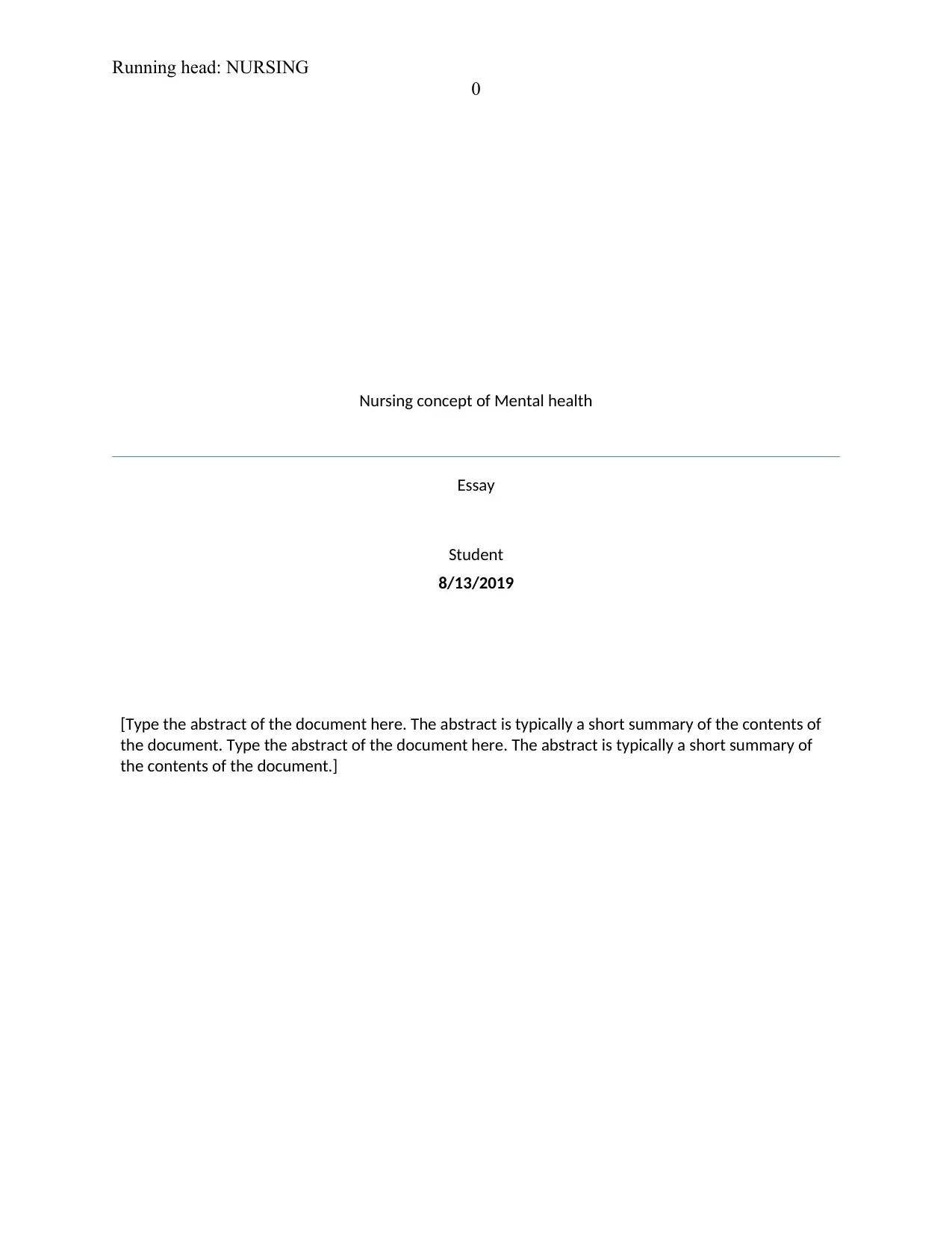
Running head: NURSING
0
Nursing concept of Mental health
Essay
Student
8/13/2019
[Type the abstract of the document here. The abstract is typically a short summary of the contents of
the document. Type the abstract of the document here. The abstract is typically a short summary of
the contents of the document.]
0
Nursing concept of Mental health
Essay
Student
8/13/2019
[Type the abstract of the document here. The abstract is typically a short summary of the contents of
the document. Type the abstract of the document here. The abstract is typically a short summary of
the contents of the document.]
Paraphrase This Document
Need a fresh take? Get an instant paraphrase of this document with our AI Paraphraser
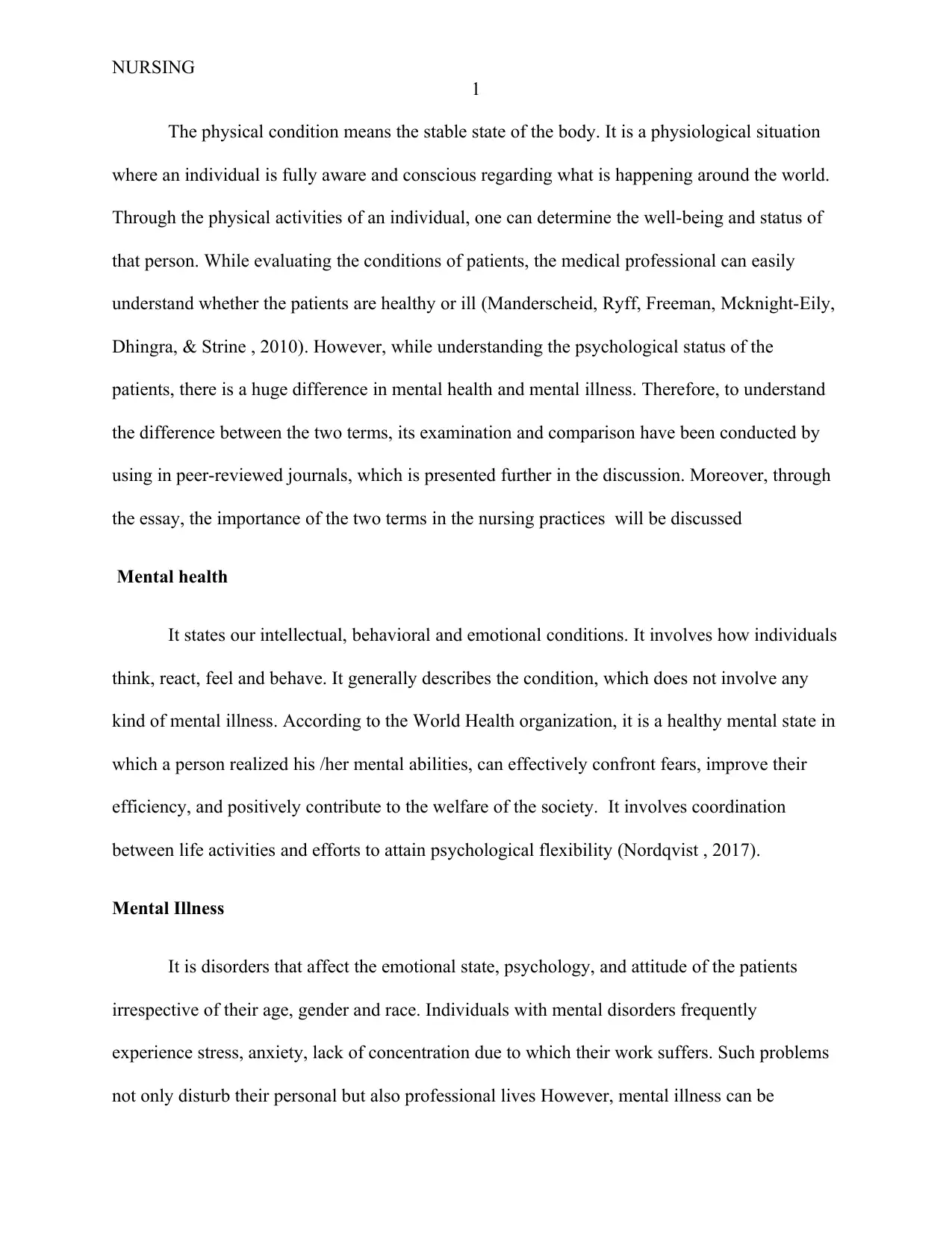
NURSING
1
The physical condition means the stable state of the body. It is a physiological situation
where an individual is fully aware and conscious regarding what is happening around the world.
Through the physical activities of an individual, one can determine the well-being and status of
that person. While evaluating the conditions of patients, the medical professional can easily
understand whether the patients are healthy or ill (Manderscheid, Ryff, Freeman, Mcknight-Eily,
Dhingra, & Strine , 2010). However, while understanding the psychological status of the
patients, there is a huge difference in mental health and mental illness. Therefore, to understand
the difference between the two terms, its examination and comparison have been conducted by
using in peer-reviewed journals, which is presented further in the discussion. Moreover, through
the essay, the importance of the two terms in the nursing practices will be discussed
Mental health
It states our intellectual, behavioral and emotional conditions. It involves how individuals
think, react, feel and behave. It generally describes the condition, which does not involve any
kind of mental illness. According to the World Health organization, it is a healthy mental state in
which a person realized his /her mental abilities, can effectively confront fears, improve their
efficiency, and positively contribute to the welfare of the society. It involves coordination
between life activities and efforts to attain psychological flexibility (Nordqvist , 2017).
Mental Illness
It is disorders that affect the emotional state, psychology, and attitude of the patients
irrespective of their age, gender and race. Individuals with mental disorders frequently
experience stress, anxiety, lack of concentration due to which their work suffers. Such problems
not only disturb their personal but also professional lives However, mental illness can be
1
The physical condition means the stable state of the body. It is a physiological situation
where an individual is fully aware and conscious regarding what is happening around the world.
Through the physical activities of an individual, one can determine the well-being and status of
that person. While evaluating the conditions of patients, the medical professional can easily
understand whether the patients are healthy or ill (Manderscheid, Ryff, Freeman, Mcknight-Eily,
Dhingra, & Strine , 2010). However, while understanding the psychological status of the
patients, there is a huge difference in mental health and mental illness. Therefore, to understand
the difference between the two terms, its examination and comparison have been conducted by
using in peer-reviewed journals, which is presented further in the discussion. Moreover, through
the essay, the importance of the two terms in the nursing practices will be discussed
Mental health
It states our intellectual, behavioral and emotional conditions. It involves how individuals
think, react, feel and behave. It generally describes the condition, which does not involve any
kind of mental illness. According to the World Health organization, it is a healthy mental state in
which a person realized his /her mental abilities, can effectively confront fears, improve their
efficiency, and positively contribute to the welfare of the society. It involves coordination
between life activities and efforts to attain psychological flexibility (Nordqvist , 2017).
Mental Illness
It is disorders that affect the emotional state, psychology, and attitude of the patients
irrespective of their age, gender and race. Individuals with mental disorders frequently
experience stress, anxiety, lack of concentration due to which their work suffers. Such problems
not only disturb their personal but also professional lives However, mental illness can be
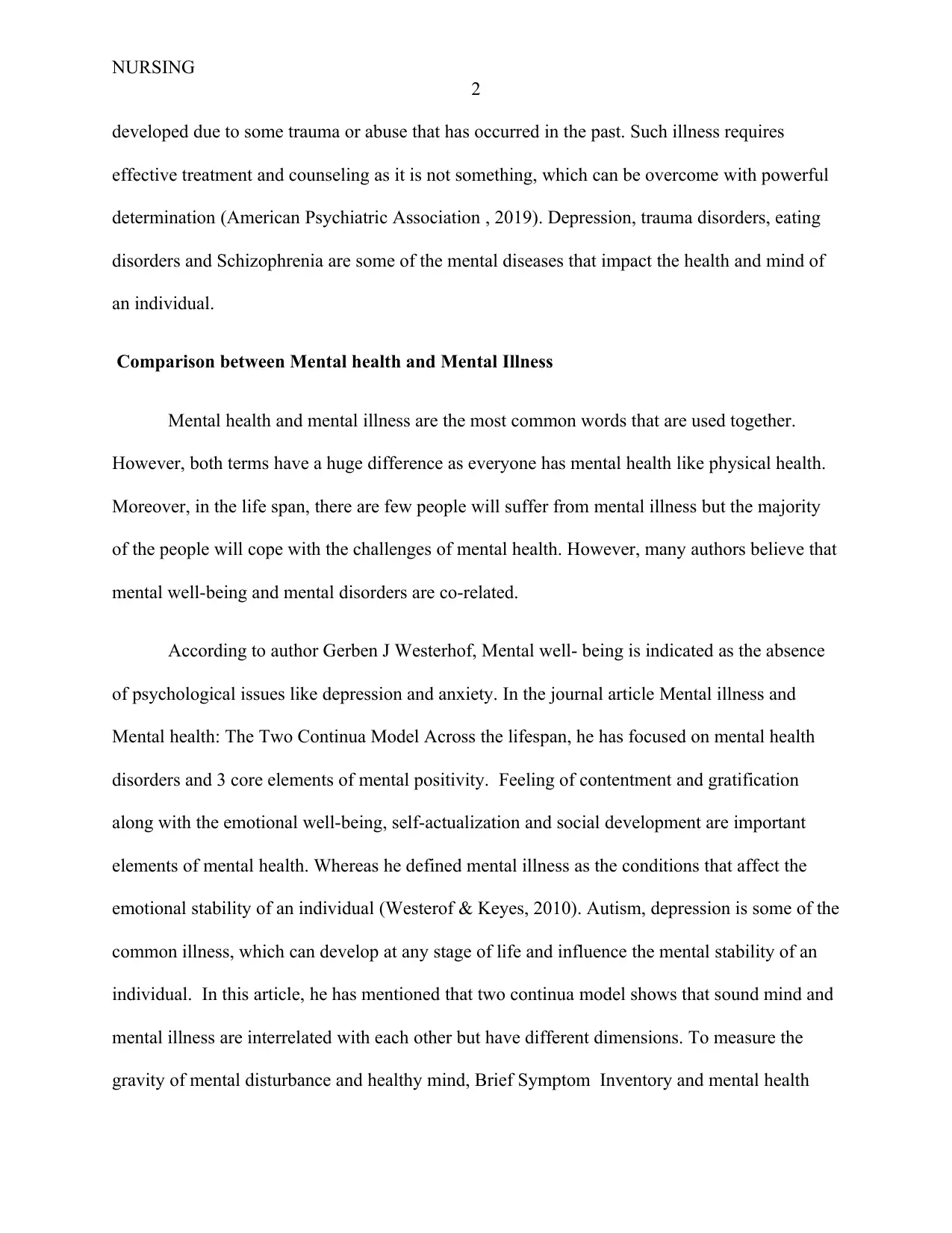
NURSING
2
developed due to some trauma or abuse that has occurred in the past. Such illness requires
effective treatment and counseling as it is not something, which can be overcome with powerful
determination (American Psychiatric Association , 2019). Depression, trauma disorders, eating
disorders and Schizophrenia are some of the mental diseases that impact the health and mind of
an individual.
Comparison between Mental health and Mental Illness
Mental health and mental illness are the most common words that are used together.
However, both terms have a huge difference as everyone has mental health like physical health.
Moreover, in the life span, there are few people will suffer from mental illness but the majority
of the people will cope with the challenges of mental health. However, many authors believe that
mental well-being and mental disorders are co-related.
According to author Gerben J Westerhof, Mental well- being is indicated as the absence
of psychological issues like depression and anxiety. In the journal article Mental illness and
Mental health: The Two Continua Model Across the lifespan, he has focused on mental health
disorders and 3 core elements of mental positivity. Feeling of contentment and gratification
along with the emotional well-being, self-actualization and social development are important
elements of mental health. Whereas he defined mental illness as the conditions that affect the
emotional stability of an individual (Westerof & Keyes, 2010). Autism, depression is some of the
common illness, which can develop at any stage of life and influence the mental stability of an
individual. In this article, he has mentioned that two continua model shows that sound mind and
mental illness are interrelated with each other but have different dimensions. To measure the
gravity of mental disturbance and healthy mind, Brief Symptom Inventory and mental health
2
developed due to some trauma or abuse that has occurred in the past. Such illness requires
effective treatment and counseling as it is not something, which can be overcome with powerful
determination (American Psychiatric Association , 2019). Depression, trauma disorders, eating
disorders and Schizophrenia are some of the mental diseases that impact the health and mind of
an individual.
Comparison between Mental health and Mental Illness
Mental health and mental illness are the most common words that are used together.
However, both terms have a huge difference as everyone has mental health like physical health.
Moreover, in the life span, there are few people will suffer from mental illness but the majority
of the people will cope with the challenges of mental health. However, many authors believe that
mental well-being and mental disorders are co-related.
According to author Gerben J Westerhof, Mental well- being is indicated as the absence
of psychological issues like depression and anxiety. In the journal article Mental illness and
Mental health: The Two Continua Model Across the lifespan, he has focused on mental health
disorders and 3 core elements of mental positivity. Feeling of contentment and gratification
along with the emotional well-being, self-actualization and social development are important
elements of mental health. Whereas he defined mental illness as the conditions that affect the
emotional stability of an individual (Westerof & Keyes, 2010). Autism, depression is some of the
common illness, which can develop at any stage of life and influence the mental stability of an
individual. In this article, he has mentioned that two continua model shows that sound mind and
mental illness are interrelated with each other but have different dimensions. To measure the
gravity of mental disturbance and healthy mind, Brief Symptom Inventory and mental health
⊘ This is a preview!⊘
Do you want full access?
Subscribe today to unlock all pages.

Trusted by 1+ million students worldwide
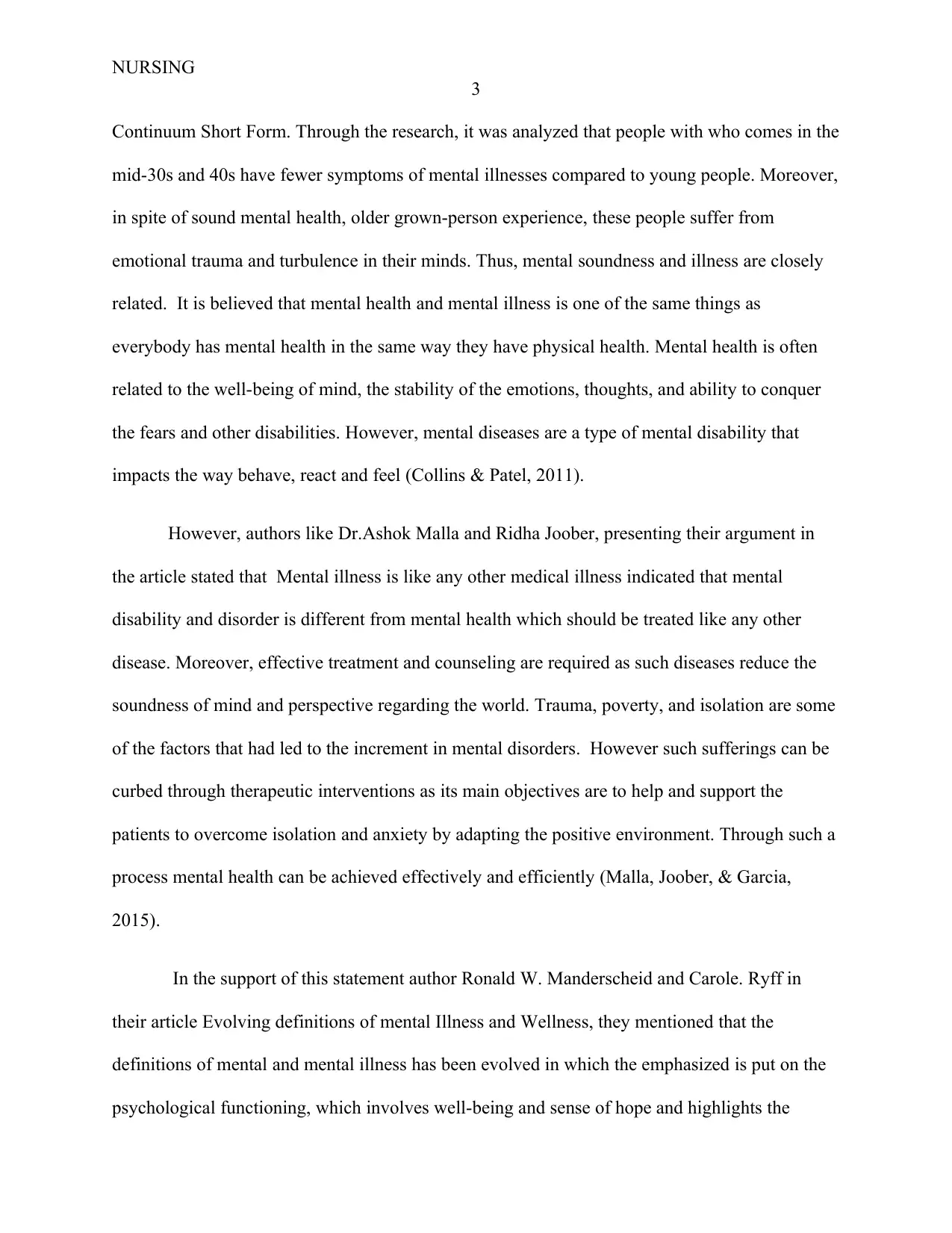
NURSING
3
Continuum Short Form. Through the research, it was analyzed that people with who comes in the
mid-30s and 40s have fewer symptoms of mental illnesses compared to young people. Moreover,
in spite of sound mental health, older grown-person experience, these people suffer from
emotional trauma and turbulence in their minds. Thus, mental soundness and illness are closely
related. It is believed that mental health and mental illness is one of the same things as
everybody has mental health in the same way they have physical health. Mental health is often
related to the well-being of mind, the stability of the emotions, thoughts, and ability to conquer
the fears and other disabilities. However, mental diseases are a type of mental disability that
impacts the way behave, react and feel (Collins & Patel, 2011).
However, authors like Dr.Ashok Malla and Ridha Joober, presenting their argument in
the article stated that Mental illness is like any other medical illness indicated that mental
disability and disorder is different from mental health which should be treated like any other
disease. Moreover, effective treatment and counseling are required as such diseases reduce the
soundness of mind and perspective regarding the world. Trauma, poverty, and isolation are some
of the factors that had led to the increment in mental disorders. However such sufferings can be
curbed through therapeutic interventions as its main objectives are to help and support the
patients to overcome isolation and anxiety by adapting the positive environment. Through such a
process mental health can be achieved effectively and efficiently (Malla, Joober, & Garcia,
2015).
In the support of this statement author Ronald W. Manderscheid and Carole. Ryff in
their article Evolving definitions of mental Illness and Wellness, they mentioned that the
definitions of mental and mental illness has been evolved in which the emphasized is put on the
psychological functioning, which involves well-being and sense of hope and highlights the
3
Continuum Short Form. Through the research, it was analyzed that people with who comes in the
mid-30s and 40s have fewer symptoms of mental illnesses compared to young people. Moreover,
in spite of sound mental health, older grown-person experience, these people suffer from
emotional trauma and turbulence in their minds. Thus, mental soundness and illness are closely
related. It is believed that mental health and mental illness is one of the same things as
everybody has mental health in the same way they have physical health. Mental health is often
related to the well-being of mind, the stability of the emotions, thoughts, and ability to conquer
the fears and other disabilities. However, mental diseases are a type of mental disability that
impacts the way behave, react and feel (Collins & Patel, 2011).
However, authors like Dr.Ashok Malla and Ridha Joober, presenting their argument in
the article stated that Mental illness is like any other medical illness indicated that mental
disability and disorder is different from mental health which should be treated like any other
disease. Moreover, effective treatment and counseling are required as such diseases reduce the
soundness of mind and perspective regarding the world. Trauma, poverty, and isolation are some
of the factors that had led to the increment in mental disorders. However such sufferings can be
curbed through therapeutic interventions as its main objectives are to help and support the
patients to overcome isolation and anxiety by adapting the positive environment. Through such a
process mental health can be achieved effectively and efficiently (Malla, Joober, & Garcia,
2015).
In the support of this statement author Ronald W. Manderscheid and Carole. Ryff in
their article Evolving definitions of mental Illness and Wellness, they mentioned that the
definitions of mental and mental illness has been evolved in which the emphasized is put on the
psychological functioning, which involves well-being and sense of hope and highlights the
Paraphrase This Document
Need a fresh take? Get an instant paraphrase of this document with our AI Paraphraser
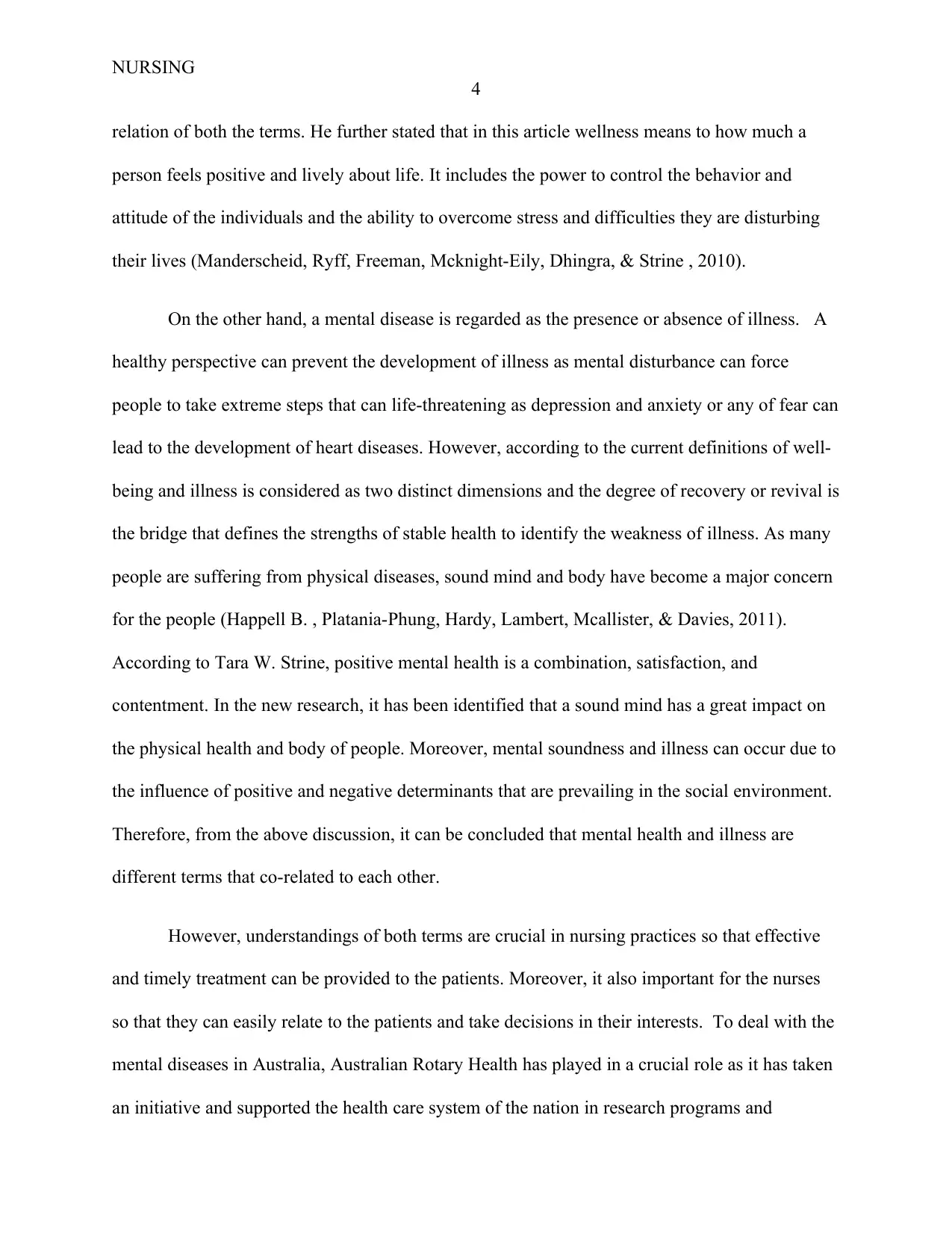
NURSING
4
relation of both the terms. He further stated that in this article wellness means to how much a
person feels positive and lively about life. It includes the power to control the behavior and
attitude of the individuals and the ability to overcome stress and difficulties they are disturbing
their lives (Manderscheid, Ryff, Freeman, Mcknight-Eily, Dhingra, & Strine , 2010).
On the other hand, a mental disease is regarded as the presence or absence of illness. A
healthy perspective can prevent the development of illness as mental disturbance can force
people to take extreme steps that can life-threatening as depression and anxiety or any of fear can
lead to the development of heart diseases. However, according to the current definitions of well-
being and illness is considered as two distinct dimensions and the degree of recovery or revival is
the bridge that defines the strengths of stable health to identify the weakness of illness. As many
people are suffering from physical diseases, sound mind and body have become a major concern
for the people (Happell B. , Platania-Phung, Hardy, Lambert, Mcallister, & Davies, 2011).
According to Tara W. Strine, positive mental health is a combination, satisfaction, and
contentment. In the new research, it has been identified that a sound mind has a great impact on
the physical health and body of people. Moreover, mental soundness and illness can occur due to
the influence of positive and negative determinants that are prevailing in the social environment.
Therefore, from the above discussion, it can be concluded that mental health and illness are
different terms that co-related to each other.
However, understandings of both terms are crucial in nursing practices so that effective
and timely treatment can be provided to the patients. Moreover, it also important for the nurses
so that they can easily relate to the patients and take decisions in their interests. To deal with the
mental diseases in Australia, Australian Rotary Health has played in a crucial role as it has taken
an initiative and supported the health care system of the nation in research programs and
4
relation of both the terms. He further stated that in this article wellness means to how much a
person feels positive and lively about life. It includes the power to control the behavior and
attitude of the individuals and the ability to overcome stress and difficulties they are disturbing
their lives (Manderscheid, Ryff, Freeman, Mcknight-Eily, Dhingra, & Strine , 2010).
On the other hand, a mental disease is regarded as the presence or absence of illness. A
healthy perspective can prevent the development of illness as mental disturbance can force
people to take extreme steps that can life-threatening as depression and anxiety or any of fear can
lead to the development of heart diseases. However, according to the current definitions of well-
being and illness is considered as two distinct dimensions and the degree of recovery or revival is
the bridge that defines the strengths of stable health to identify the weakness of illness. As many
people are suffering from physical diseases, sound mind and body have become a major concern
for the people (Happell B. , Platania-Phung, Hardy, Lambert, Mcallister, & Davies, 2011).
According to Tara W. Strine, positive mental health is a combination, satisfaction, and
contentment. In the new research, it has been identified that a sound mind has a great impact on
the physical health and body of people. Moreover, mental soundness and illness can occur due to
the influence of positive and negative determinants that are prevailing in the social environment.
Therefore, from the above discussion, it can be concluded that mental health and illness are
different terms that co-related to each other.
However, understandings of both terms are crucial in nursing practices so that effective
and timely treatment can be provided to the patients. Moreover, it also important for the nurses
so that they can easily relate to the patients and take decisions in their interests. To deal with the
mental diseases in Australia, Australian Rotary Health has played in a crucial role as it has taken
an initiative and supported the health care system of the nation in research programs and
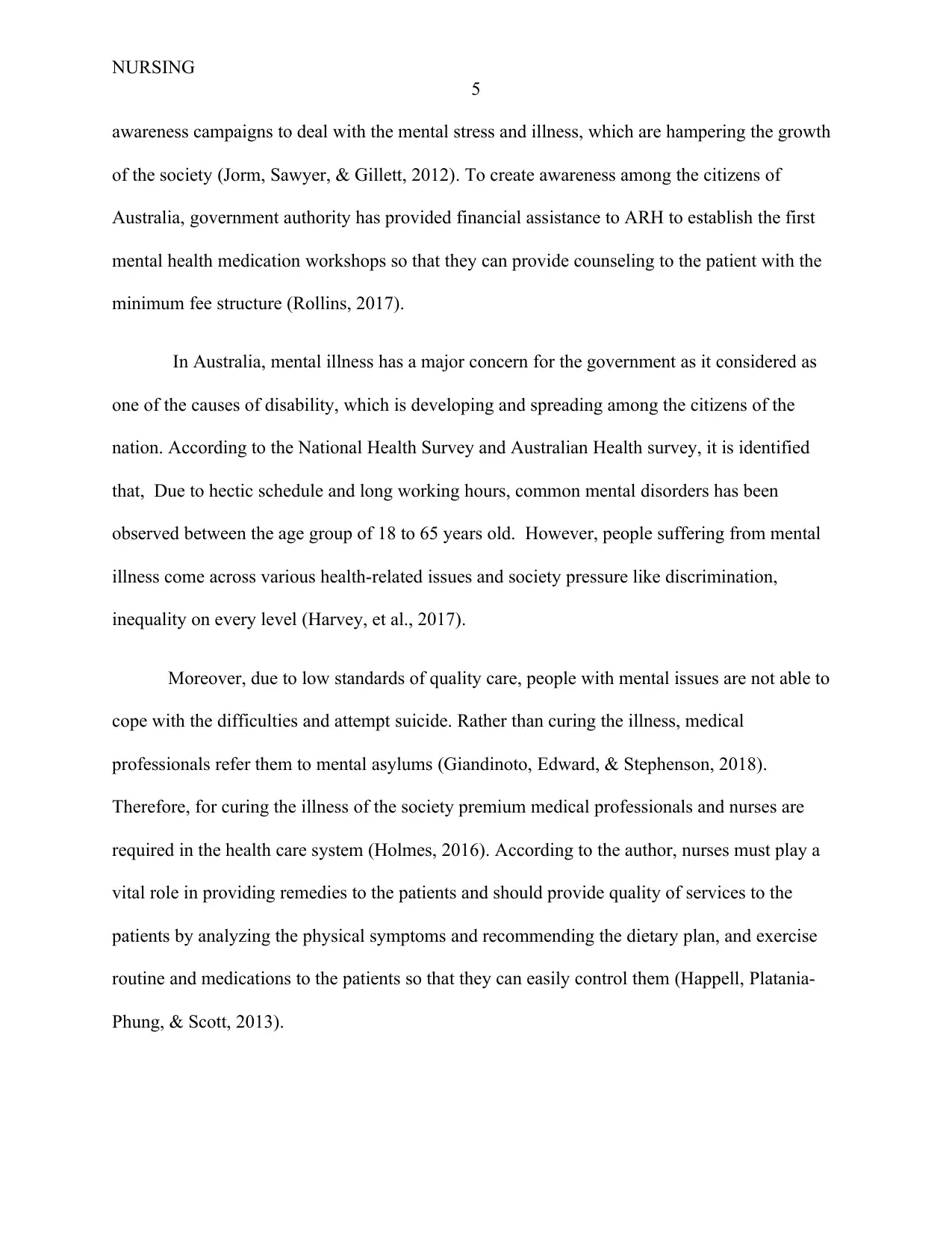
NURSING
5
awareness campaigns to deal with the mental stress and illness, which are hampering the growth
of the society (Jorm, Sawyer, & Gillett, 2012). To create awareness among the citizens of
Australia, government authority has provided financial assistance to ARH to establish the first
mental health medication workshops so that they can provide counseling to the patient with the
minimum fee structure (Rollins, 2017).
In Australia, mental illness has a major concern for the government as it considered as
one of the causes of disability, which is developing and spreading among the citizens of the
nation. According to the National Health Survey and Australian Health survey, it is identified
that, Due to hectic schedule and long working hours, common mental disorders has been
observed between the age group of 18 to 65 years old. However, people suffering from mental
illness come across various health-related issues and society pressure like discrimination,
inequality on every level (Harvey, et al., 2017).
Moreover, due to low standards of quality care, people with mental issues are not able to
cope with the difficulties and attempt suicide. Rather than curing the illness, medical
professionals refer them to mental asylums (Giandinoto, Edward, & Stephenson, 2018).
Therefore, for curing the illness of the society premium medical professionals and nurses are
required in the health care system (Holmes, 2016). According to the author, nurses must play a
vital role in providing remedies to the patients and should provide quality of services to the
patients by analyzing the physical symptoms and recommending the dietary plan, and exercise
routine and medications to the patients so that they can easily control them (Happell, Platania-
Phung, & Scott, 2013).
5
awareness campaigns to deal with the mental stress and illness, which are hampering the growth
of the society (Jorm, Sawyer, & Gillett, 2012). To create awareness among the citizens of
Australia, government authority has provided financial assistance to ARH to establish the first
mental health medication workshops so that they can provide counseling to the patient with the
minimum fee structure (Rollins, 2017).
In Australia, mental illness has a major concern for the government as it considered as
one of the causes of disability, which is developing and spreading among the citizens of the
nation. According to the National Health Survey and Australian Health survey, it is identified
that, Due to hectic schedule and long working hours, common mental disorders has been
observed between the age group of 18 to 65 years old. However, people suffering from mental
illness come across various health-related issues and society pressure like discrimination,
inequality on every level (Harvey, et al., 2017).
Moreover, due to low standards of quality care, people with mental issues are not able to
cope with the difficulties and attempt suicide. Rather than curing the illness, medical
professionals refer them to mental asylums (Giandinoto, Edward, & Stephenson, 2018).
Therefore, for curing the illness of the society premium medical professionals and nurses are
required in the health care system (Holmes, 2016). According to the author, nurses must play a
vital role in providing remedies to the patients and should provide quality of services to the
patients by analyzing the physical symptoms and recommending the dietary plan, and exercise
routine and medications to the patients so that they can easily control them (Happell, Platania-
Phung, & Scott, 2013).
⊘ This is a preview!⊘
Do you want full access?
Subscribe today to unlock all pages.

Trusted by 1+ million students worldwide
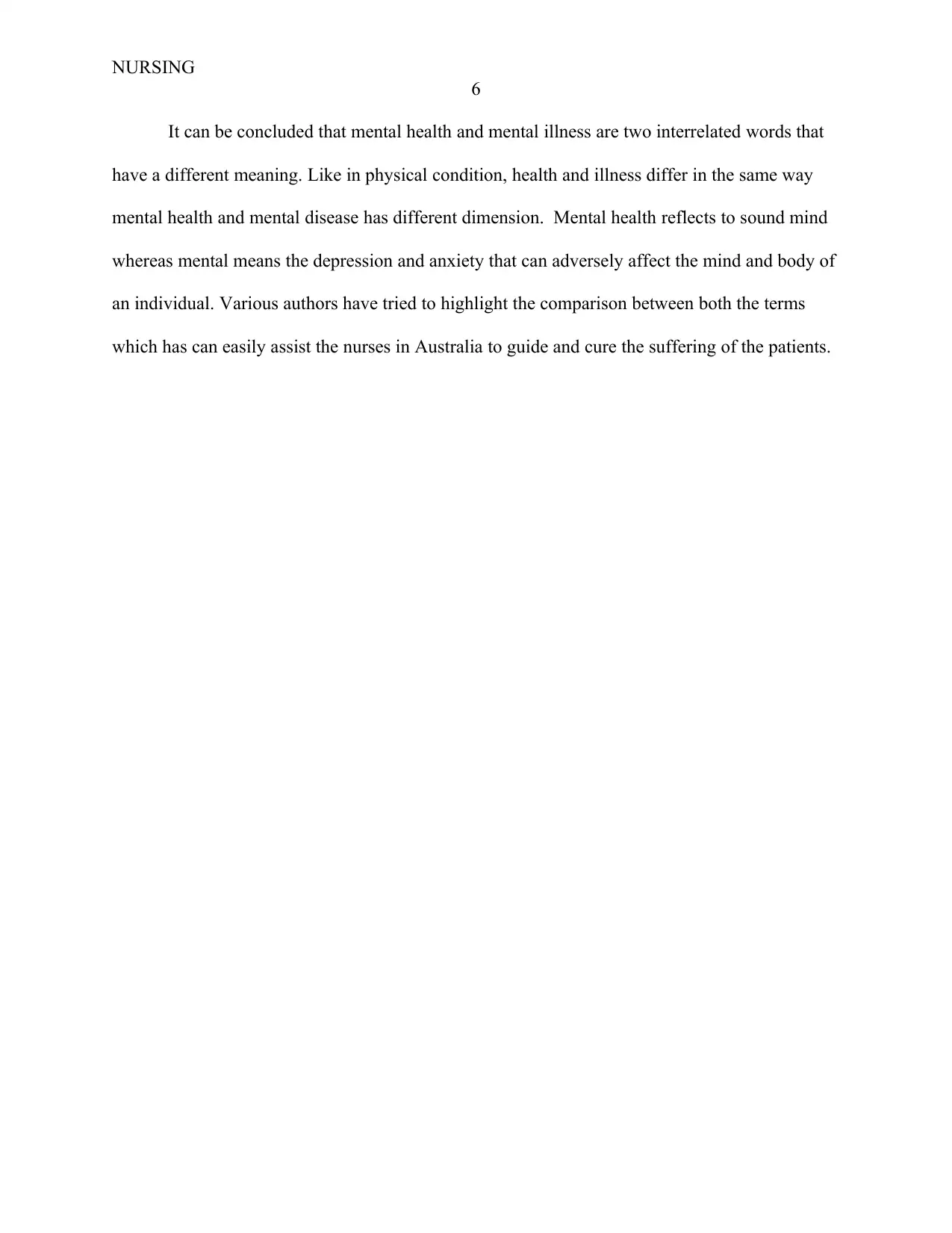
NURSING
6
It can be concluded that mental health and mental illness are two interrelated words that
have a different meaning. Like in physical condition, health and illness differ in the same way
mental health and mental disease has different dimension. Mental health reflects to sound mind
whereas mental means the depression and anxiety that can adversely affect the mind and body of
an individual. Various authors have tried to highlight the comparison between both the terms
which has can easily assist the nurses in Australia to guide and cure the suffering of the patients.
6
It can be concluded that mental health and mental illness are two interrelated words that
have a different meaning. Like in physical condition, health and illness differ in the same way
mental health and mental disease has different dimension. Mental health reflects to sound mind
whereas mental means the depression and anxiety that can adversely affect the mind and body of
an individual. Various authors have tried to highlight the comparison between both the terms
which has can easily assist the nurses in Australia to guide and cure the suffering of the patients.
Paraphrase This Document
Need a fresh take? Get an instant paraphrase of this document with our AI Paraphraser
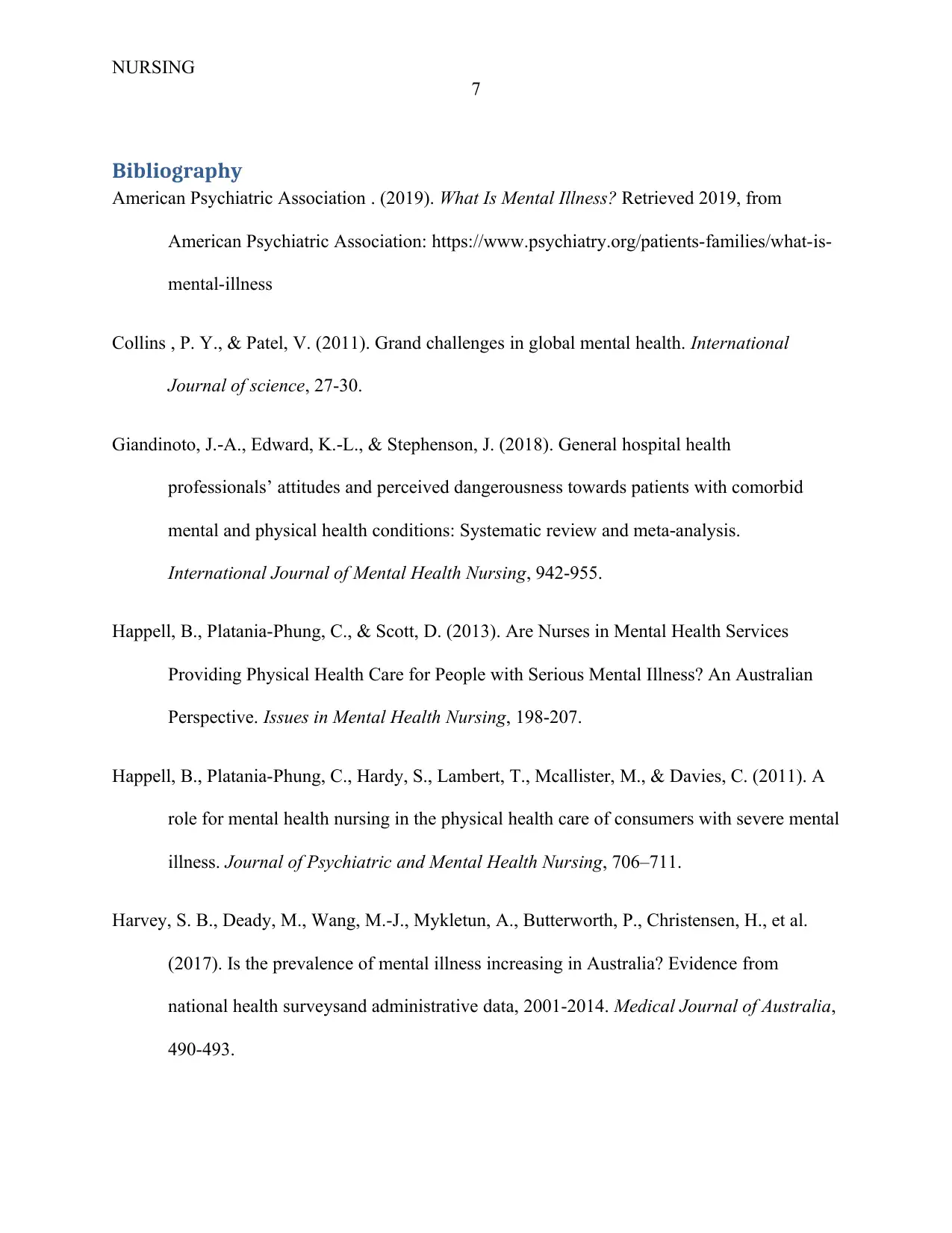
NURSING
7
Bibliography
American Psychiatric Association . (2019). What Is Mental Illness? Retrieved 2019, from
American Psychiatric Association: https://www.psychiatry.org/patients-families/what-is-
mental-illness
Collins , P. Y., & Patel, V. (2011). Grand challenges in global mental health. International
Journal of science, 27-30.
Giandinoto, J. A., Edward, K. L., & Stephenson, J. (2018). General hospital health‐ ‐
professionals’ attitudes and perceived dangerousness towards patients with comorbid
mental and physical health conditions: Systematic review and meta analysis.‐
International Journal of Mental Health Nursing, 942-955.
Happell, B., Platania-Phung, C., & Scott, D. (2013). Are Nurses in Mental Health Services
Providing Physical Health Care for People with Serious Mental Illness? An Australian
Perspective. Issues in Mental Health Nursing, 198-207.
Happell, B., Platania-Phung, C., Hardy, S., Lambert, T., Mcallister, M., & Davies, C. (2011). A
role for mental health nursing in the physical health care of consumers with severe mental
illness. Journal of Psychiatric and Mental Health Nursing, 706–711.
Harvey, S. B., Deady, M., Wang, M.-J., Mykletun, A., Butterworth, P., Christensen, H., et al.
(2017). Is the prevalence of mental illness increasing in Australia? Evidence from
national health surveysand administrative data, 2001-2014. Medical Journal of Australia,
490-493.
7
Bibliography
American Psychiatric Association . (2019). What Is Mental Illness? Retrieved 2019, from
American Psychiatric Association: https://www.psychiatry.org/patients-families/what-is-
mental-illness
Collins , P. Y., & Patel, V. (2011). Grand challenges in global mental health. International
Journal of science, 27-30.
Giandinoto, J. A., Edward, K. L., & Stephenson, J. (2018). General hospital health‐ ‐
professionals’ attitudes and perceived dangerousness towards patients with comorbid
mental and physical health conditions: Systematic review and meta analysis.‐
International Journal of Mental Health Nursing, 942-955.
Happell, B., Platania-Phung, C., & Scott, D. (2013). Are Nurses in Mental Health Services
Providing Physical Health Care for People with Serious Mental Illness? An Australian
Perspective. Issues in Mental Health Nursing, 198-207.
Happell, B., Platania-Phung, C., Hardy, S., Lambert, T., Mcallister, M., & Davies, C. (2011). A
role for mental health nursing in the physical health care of consumers with severe mental
illness. Journal of Psychiatric and Mental Health Nursing, 706–711.
Harvey, S. B., Deady, M., Wang, M.-J., Mykletun, A., Butterworth, P., Christensen, H., et al.
(2017). Is the prevalence of mental illness increasing in Australia? Evidence from
national health surveysand administrative data, 2001-2014. Medical Journal of Australia,
490-493.
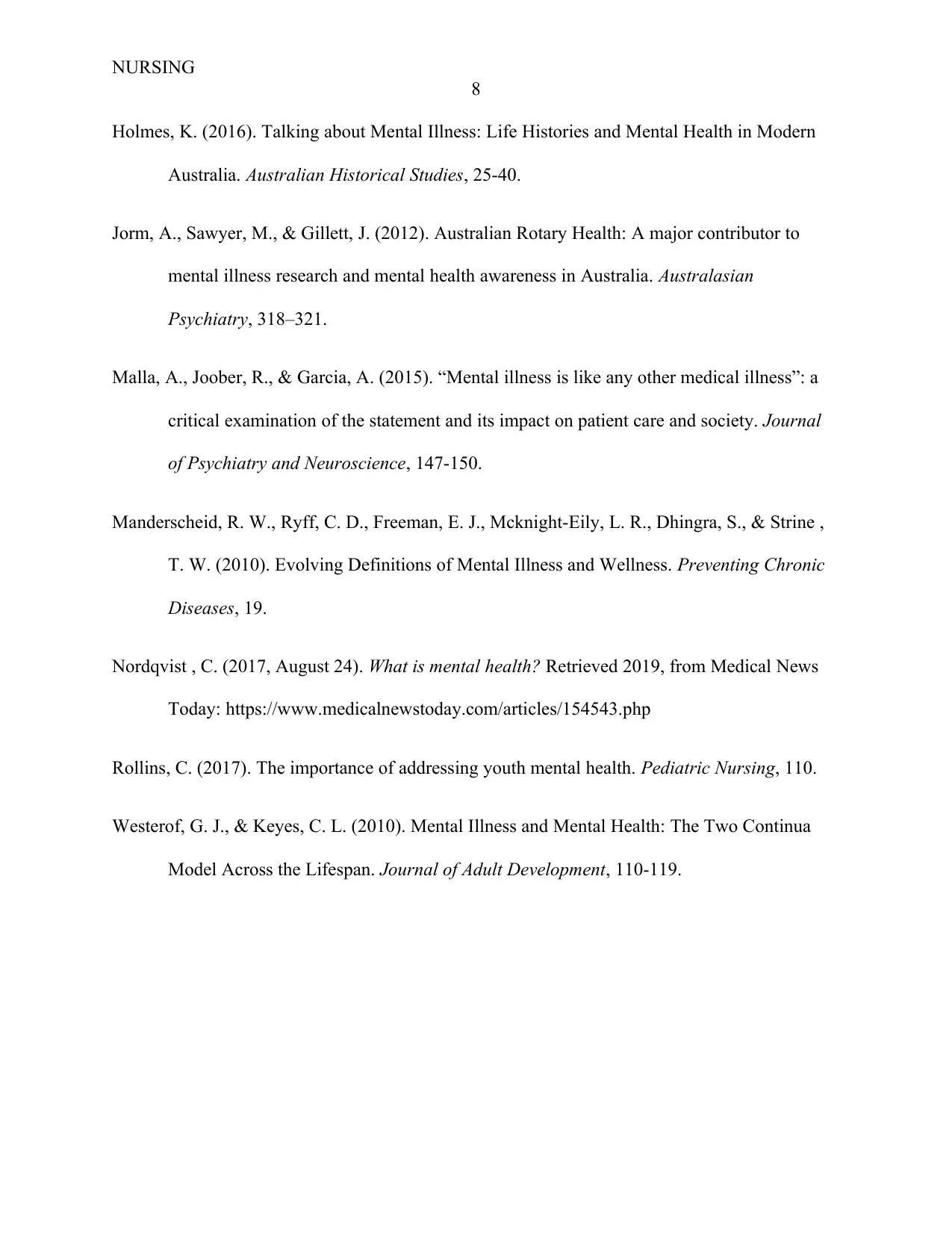
NURSING
8
Holmes, K. (2016). Talking about Mental Illness: Life Histories and Mental Health in Modern
Australia. Australian Historical Studies, 25-40.
Jorm, A., Sawyer, M., & Gillett, J. (2012). Australian Rotary Health: A major contributor to
mental illness research and mental health awareness in Australia. Australasian
Psychiatry, 318–321.
Malla, A., Joober, R., & Garcia, A. (2015). “Mental illness is like any other medical illness”: a
critical examination of the statement and its impact on patient care and society. Journal
of Psychiatry and Neuroscience, 147-150.
Manderscheid, R. W., Ryff, C. D., Freeman, E. J., Mcknight-Eily, L. R., Dhingra, S., & Strine ,
T. W. (2010). Evolving Definitions of Mental Illness and Wellness. Preventing Chronic
Diseases, 19.
Nordqvist , C. (2017, August 24). What is mental health? Retrieved 2019, from Medical News
Today: https://www.medicalnewstoday.com/articles/154543.php
Rollins, C. (2017). The importance of addressing youth mental health. Pediatric Nursing, 110.
Westerof, G. J., & Keyes, C. L. (2010). Mental Illness and Mental Health: The Two Continua
Model Across the Lifespan. Journal of Adult Development, 110-119.
8
Holmes, K. (2016). Talking about Mental Illness: Life Histories and Mental Health in Modern
Australia. Australian Historical Studies, 25-40.
Jorm, A., Sawyer, M., & Gillett, J. (2012). Australian Rotary Health: A major contributor to
mental illness research and mental health awareness in Australia. Australasian
Psychiatry, 318–321.
Malla, A., Joober, R., & Garcia, A. (2015). “Mental illness is like any other medical illness”: a
critical examination of the statement and its impact on patient care and society. Journal
of Psychiatry and Neuroscience, 147-150.
Manderscheid, R. W., Ryff, C. D., Freeman, E. J., Mcknight-Eily, L. R., Dhingra, S., & Strine ,
T. W. (2010). Evolving Definitions of Mental Illness and Wellness. Preventing Chronic
Diseases, 19.
Nordqvist , C. (2017, August 24). What is mental health? Retrieved 2019, from Medical News
Today: https://www.medicalnewstoday.com/articles/154543.php
Rollins, C. (2017). The importance of addressing youth mental health. Pediatric Nursing, 110.
Westerof, G. J., & Keyes, C. L. (2010). Mental Illness and Mental Health: The Two Continua
Model Across the Lifespan. Journal of Adult Development, 110-119.
⊘ This is a preview!⊘
Do you want full access?
Subscribe today to unlock all pages.

Trusted by 1+ million students worldwide
1 out of 9
Related Documents
Your All-in-One AI-Powered Toolkit for Academic Success.
+13062052269
info@desklib.com
Available 24*7 on WhatsApp / Email
![[object Object]](/_next/static/media/star-bottom.7253800d.svg)
Unlock your academic potential
Copyright © 2020–2025 A2Z Services. All Rights Reserved. Developed and managed by ZUCOL.





